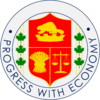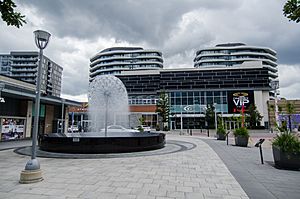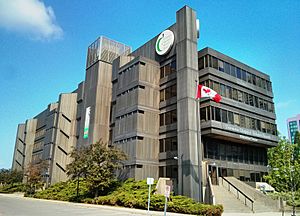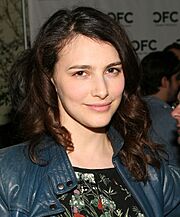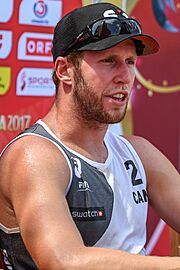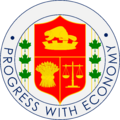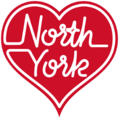North York facts for kids
Quick facts for kids
North York
|
|||||
|---|---|---|---|---|---|
|
Dissolved city (lower-tier)
|
|||||

North York skyline in 2021
|
|||||
|
|||||
| Nickname(s):
The City with Heart
|
|||||
| Motto(s):
Progress With Economy
|
|||||
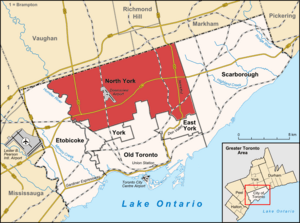
Location of North York (red) within the rest of Toronto.
|
|||||
| Country | Canada | ||||
| Province | Ontario | ||||
| Municipality | Toronto | ||||
| Incorporated | June 13, 1922 (Township) January 1, 1967 (Borough) February 14, 1979 (City) January 1, 1998 (District of Toronto) |
||||
| Changed Region | 1953 Metropolitan Toronto from York County | ||||
| Amalgamated | January 1, 1998 into Toronto | ||||
| Area | |||||
| • Total | 176.87 km2 (68.29 sq mi) | ||||
| Population
(2021)
|
|||||
| • Total | 683,511 | ||||
| • Density | 3,864.5/km2 (10,009/sq mi) | ||||
| Area code(s) | 416, 647, and 437 | ||||
North York is a former city and is now one of the six main areas of Toronto, Ontario, Canada. It is located in the northern part of Toronto. You can find it around Yonge Street, just north of Ontario Highway 401.
North York is bordered by York Region to the north at Steeles Avenue. To the west, it's next to the Humber River, and to the east, it borders Victoria Park Avenue. Its southern edge is a bit uneven, following the old borders of other Toronto areas like York, Old Toronto, and East York. In 2016, about 644,685 people lived in North York.
North York started as a "township" in 1922. This happened when the northern part of the old York township separated. In 1953, it became part of Metropolitan Toronto. North York grew very quickly because it was close to Toronto. It became a "borough" in 1967 and then a "city" in 1979. Many homes, public transport, and company offices were built in North York City Centre. In 1998, North York joined with other areas to form the new City of Toronto. Today, it is still an important business area, second only to Downtown Toronto.
Contents
North York's Story

The area known as the Township of North York was officially created on June 13, 1922. Before this, it was a rural part of the Township of York. The southern part of York, closer to the old City of Toronto, was becoming more like a city. But the northern part was still mostly farms.
Farmers in the north felt they paid a lot of taxes but didn't get many services. A dairy farmer named Robert Franklin Hicks helped organize other farmers. They asked the government of Ontario to create a separate township for the northern area. The people voted, and most agreed to separate from York.
North York stayed mostly farmland until World War II. After the war, in the late 1940s and 1950s, there weren't enough houses. So, North York grew quickly as a suburb of Toronto, and many people moved there. In 1953, the province joined 11 townships and villages, including North York, with the Old City of Toronto. This new larger area was called Metropolitan Toronto.
As more people moved to North York, it changed from a township to the Borough of North York in 1967. Then, on February 14, 1979, it became the City of North York. Because it became a city on Valentine's Day, its slogan was "The City with Heart."
North York became part of the larger City of Toronto on January 1, 1998. Now, it is the biggest part of the area served by the "North York Community Council." This council is a group of local leaders within the Toronto City Council.
Important Events
On August 10, 2008, a large propane explosion happened at a facility near Downsview Airport. This explosion destroyed the building and damaged nearby homes. About 13,000 people had to leave their homes for several days. Sadly, one worker and one firefighter died. After the accident, officials looked into what happened. They suggested reviewing how far propane storage places should be from homes to make sure everyone stays safe.
Weather in North York
| Climate data for North York (1981−2010) | |||||||||||||
|---|---|---|---|---|---|---|---|---|---|---|---|---|---|
| Month | Jan | Feb | Mar | Apr | May | Jun | Jul | Aug | Sep | Oct | Nov | Dec | Year |
| Record high °C (°F) | 15.5 (59.9) |
15.0 (59.0) |
25.5 (77.9) |
29.5 (85.1) |
34.0 (93.2) |
35.5 (95.9) |
36.0 (96.8) |
37.5 (99.5) |
34.5 (94.1) |
29.5 (85.1) |
23.0 (73.4) |
18.0 (64.4) |
37.5 (99.5) |
| Mean daily maximum °C (°F) | −1.1 (30.0) |
0.5 (32.9) |
5.1 (41.2) |
12.0 (53.6) |
18.8 (65.8) |
24.9 (76.8) |
27.3 (81.1) |
26.5 (79.7) |
22.3 (72.1) |
14.5 (58.1) |
7.8 (46.0) |
2.0 (35.6) |
13.4 (56.1) |
| Daily mean °C (°F) | −5 (23) |
−3.7 (25.3) |
0.5 (32.9) |
6.7 (44.1) |
13.1 (55.6) |
19.2 (66.6) |
21.6 (70.9) |
20.9 (69.6) |
16.8 (62.2) |
9.8 (49.6) |
4.1 (39.4) |
−1.4 (29.5) |
8.6 (47.5) |
| Mean daily minimum °C (°F) | −8.8 (16.2) |
−7.8 (18.0) |
−4.1 (24.6) |
1.4 (34.5) |
7.3 (45.1) |
13.5 (56.3) |
15.9 (60.6) |
15.3 (59.5) |
11.3 (52.3) |
5.1 (41.2) |
0.4 (32.7) |
−4.9 (23.2) |
3.7 (38.7) |
| Record low °C (°F) | −26.0 (−14.8) |
−23.5 (−10.3) |
−25.5 (−13.9) |
−10.0 (14.0) |
−2.5 (27.5) |
3.0 (37.4) |
7.0 (44.6) |
5.5 (41.9) |
−0.5 (31.1) |
−5.5 (22.1) |
−12.5 (9.5) |
−26.0 (−14.8) |
−26.0 (−14.8) |
| Average precipitation mm (inches) | 72.5 (2.85) |
53.3 (2.10) |
52.4 (2.06) |
74.1 (2.92) |
90.3 (3.56) |
85.5 (3.37) |
80.2 (3.16) |
74.0 (2.91) |
82.3 (3.24) |
66.7 (2.63) |
79.4 (3.13) |
61.3 (2.41) |
871.9 (34.33) |
| Average rainfall mm (inches) | 37.2 (1.46) |
31.9 (1.26) |
29.2 (1.15) |
64.9 (2.56) |
90.3 (3.56) |
85.5 (3.37) |
80.2 (3.16) |
74.0 (2.91) |
82.3 (3.24) |
66.5 (2.62) |
69.6 (2.74) |
34.6 (1.36) |
746.2 (29.38) |
| Average snowfall cm (inches) | 37.8 (14.9) |
21.1 (8.3) |
23.7 (9.3) |
5.5 (2.2) |
0.02 (0.01) |
0.0 (0.0) |
0.0 (0.0) |
0.0 (0.0) |
0.0 (0.0) |
0.2 (0.1) |
10.5 (4.1) |
26.5 (10.4) |
125.2 (49.3) |
| Average precipitation days (≥ 0.2 mm) | 16.7 | 12.3 | 12.4 | 12.7 | 12.9 | 11.9 | 11.6 | 10.1 | 11.1 | 12.8 | 14.4 | 13.9 | 152.7 |
| Average rainy days (≥ 0.2 mm) | 6.5 | 5.5 | 6.7 | 11.3 | 12.9 | 11.9 | 11.6 | 10.1 | 11.1 | 12.7 | 11.0 | 6.9 | 118.1 |
| Average snowy days (≥ 0.2 cm) | 13.3 | 8.8 | 7.2 | 2.7 | 0.08 | 0.0 | 0.0 | 0.0 | 0.0 | 0.17 | 4.6 | 9.2 | 46.0 |
| Source: Environment Canada | |||||||||||||
North York Neighbourhoods
North York has many different neighbourhoods. Each one has its own unique feel and community.
People of North York
In 2021, North York had a population of 683,511 people. This was a small increase from 2016. North York is known for being a very diverse place with many different cultures.
Here's a look at the different backgrounds of people in North York in 2016:
| Ethnic groups in North York (2016) Source: 2016 Canadian Census |
Population | % | |
|---|---|---|---|
| Ethnic origins | European | 349,150 | 40.6% |
| East Asian | 123,280 | 14.3% | |
| Southeast Asian | 85,115 | 9.9% | |
| Black | 84,415 | 9.8% | |
| South Asian | 75,995 | 8.8% | |
| Middle Eastern | 49,060 | 5.7% | |
| Latin American | 35,840 | 4.2% | |
| Aboriginal | 7,035 | 0.8% | |
| Other | 4,165 | 0.5% | |
| Total population | 869,401 | 100% | |
Many different languages are spoken in North York. Here are the top ten languages spoken at home:
| Mother Tongue Languages | Population | Percentage |
|---|---|---|
| English | 280,320 | 43.9% |
| Mandarin | 40,125 | 6.3% |
| Persian | 30,465 | 4.8% |
| Tagalog (Pilipino, Filipino) | 28,810 | 4.5% |
| Cantonese | 27,665 | 4.3% |
| Russian | 20,320 | 3.2% |
| Korean | 19,265 | 3.0% |
| Spanish | 16,220 | 2.5% |
| Italian | 15,440 | 2.4% |
| Urdu | 10,325 | 1.6% |
| Others | 123,895 | 19.4% |
| Multiple Responses | 25,255 | 4.0% |
North York's Economy

The main business area in North York is called North York City Centre. This was where the former city's government offices and big company headquarters were located. North York Centre is still a major business hub in Toronto. It has many office buildings and companies. The old city hall of North York, the North York Civic Centre, is also in this area.
Downsview Airport, near Sheppard and Allen Road, provides jobs for 1,800 people. This airport will also be home to the Centennial College Aerospace campus. This is a big investment of $60 million from the Canadian government. Many private companies are also partners in this project.
Flemingdon Park, near Eglinton and Don Mills, is another important business area. It is close to the busy Don Valley Parkway and public transit routes. Companies like McDonald's Canada and Celestica have offices here. Home Depot Canada has its main Canadian office in Flemingdon Park.
North York has two of Toronto's five biggest shopping malls: the Yorkdale Shopping Centre and Fairview Mall. Other shopping centres include Centerpoint Mall, Bayview Village, and Shops at Don Mills.
Healthcare is also a major industry in North York. The area has several large hospitals. These include the North York General Hospital, Humber River Hospital, and the Sunnybrook Health Sciences Centre.
Learning in North York
Before 1998, different school boards managed schools in North York. Now, four public school boards run schools for younger and older students in the area.
- Conseil scolaire catholique MonAvenir (CSCM)
- Conseil scolaire Viamonde (CSV)
- Toronto Catholic District School Board (TCDSB)
- Toronto District School Board (TDSB)
CSV and TDSB are public school boards that do not teach religion. CSV offers French-language schools, while TDSB offers English-language schools. CSCM and TCDSB are public school boards that do teach religion. CSCM has French-language religious schools, and TCDSB has English-language religious schools. All four of these public school boards have their main offices in North York.
Besides schools for kids, North York also has several places for higher education. York University started in 1959. It has two campuses in North York: the Keele campus and Glendon College. Glendon College is a bilingual campus where students can learn in both English and French.
There are also two colleges with campuses in North York. Seneca College opened in North York in 1967 and has several campuses here. One of Centennial College's campuses, the Downsview Park Aerospace Campus, is also in North York.
How North York is Governed
North York is an area within the City of Toronto. It is represented by councillors who are elected to the Toronto City Council. People from North York also elect members to the Legislative Assembly of Ontario and the Parliament of Canada. The North York Civic Centre is used by North York's community council and other city offices that serve the area.
Before North York joined Toronto in 1998, it was its own municipality. It had its own council, the North York City Council, which met at the North York Civic Centre. Below is a list of the leaders of North York, called "reeves" and "mayors."
Past Leaders
Township of North York
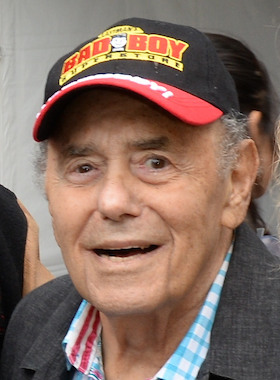
- 1922–1929 Robert Franklin Hicks: He was a dairy farmer who helped North York become a separate township. During his time as the first reeve, new services like a public health board and water system were created.
- 1929–1930 James Muirhead: A farmer who was a founding member of the township council.
- 1931–1933 George B. Elliott: He faced challenges during the Great Depression, like demands for help for unemployed people.
- 1934–1940 Robert Earl Bales: He was North York's youngest reeve at 37. Earl Bales Park is named after him. Under his leadership, North York was able to pay off its debt from the Great Depression.
- 1941–1949 George Herbert Mitchell: He also served in the Ontario legislature. He made sure snowplows kept roads open for expectant mothers in winter.
- 1950–1952 Nelson A. Boylen: He worked in the dairy industry for 50 years. He was against North York joining Metropolitan Toronto.
- 1953–1956 Frederick Joseph McMahon: He supported the creation of Metropolitan Toronto. He later became a judge.
- 1957–1958 Vernon M. Singer: He later served as a Member of Provincial Parliament.
- 1959–1964 Norman C. Goodhead: As reeve, he was against illegal basement apartments.
- 1965–1966 James Ditson Service: He campaigned to build the North York Civic Centre and develop the area with tall office buildings. He also wanted a large domed stadium.
Borough of North York
- 1967–1969 James Ditson Service
- 1970–1972 Basil H. Hall: He supported building and extending a major highway.
- 1973–1978 Mel Lastman
City of North York
- 1979–1997 Mel Lastman: He was the last mayor of North York. He then became the first mayor of the new City of Toronto from 1998 to 2003.
Media in North York
- North York Mirror: This was a local newspaper that covered news in North York. It started in 1957 and stopped printing in 2023.
- Salam Toronto: This is a weekly newspaper for the Iranian community in North York. It is printed in both Persian and English.
Fun and Recreation
Museums to Visit
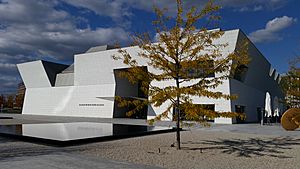
North York has several museums. The Canadian Air and Space Museum used to be here, but it moved in 2019. You can visit Black Creek Pioneer Village, which is like stepping back in time to a nineteenth-century village. The Ontario Science Centre was an interactive science museum, but it closed in June 2024. The Aga Khan Museum has a beautiful collection of Islamic art from the Middle East and North Africa.
Sports and Activities
The Downsview neighbourhood has a former military base that is now a large park called Downsview Park. Inside the park is the Downsview Park Sports Centre. This is a huge sports facility built by Maple Leaf Sports & Entertainment (MLSE), who own the Toronto FC soccer team. MLSE spent $26 million to build the Kia Training Ground, which is a modern practice facility for Toronto FC. Volleyball Canada also has its main office and training centre at Downsview Park.
North York has many sports clubs. These include the North York Storm, a girls' hockey league, and the North York Aquatic Club for swimming. The Granite Club is a private sports club that expanded in North York in 2012.
The Oakdale Golf & Country Club is a private golf and tennis club in North York. It hosted the 2023 Canadian Open golf tournament and will host it again in 2026.
The North York Ski Centre at Earl Bales Park is a unique urban ski centre. It has a new four-person chairlift. Sports clubs in North York include:
- York United FC (soccer)
- Toronto FC II (soccer)
- North York Astros (soccer)
- North York Rockets (soccer - no longer active)
- North York Rangers (hockey)
- North York Storm (girls' hockey)
- North York Aquatic Club (swimming)
- North York Fire Basketball
- North York Hockey League
- North York Hearts Azzurri Soccer Club (soccer)
- North York Baseball Association
- Hayabusakan Judo Club
Getting Around North York
Several major highways run through North York. These include Highway 400, Highway 401, Highway 404, Allen Road, and the Don Valley Parkway. Highways 400, 401, and 404 are managed by the province. Allen Road and the Don Valley Parkway are managed by the City of Toronto. The part of Highway 401 in North York is one of the busiest highways in North America. More than 400,000 vehicles use it every day.
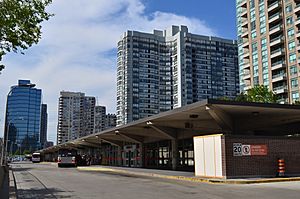
Most public transportation in North York is provided by the Toronto Transit Commission (TTC). This includes their bus and subway system. Two subway lines have stations in North York: Line 1 Yonge–University and Line 4 Sheppard. Finch station, at the end of the Yonge–University line, is a very busy subway and bus station.
The Line 4 Sheppard subway runs entirely within North York. It goes from the Yonge-University line at Sheppard Avenue east to Fairview Mall. Two new light rail lines are being built: Line 5 Eglinton will go through southeast North York, and Line 6 Finch West will go through the northwest. The Ontario Line is also expected to have two stops in North York.
Besides the TTC, you can also use GO Transit and York Region Transit from North York. GO Transit offers commuter rail and bus services to other communities around Toronto. You can access these services at GO or TTC stations in North York.
Famous People from North York
- Michael Adamthwaite (born 1981), voice actor
- Liane Balaban (born 1980), actress
- Andy Borodow (born 1969), Olympic wrestler
- John Bregar, actor
- Chris Campoli, professional ice hockey player
- Candi & The Backbeat, pop band
- Kurtis Conner (born 1994), stand-up comedian and YouTuber
- Tie Domi, former professional ice hockey player
- Louis Ferreira, actor
- Yani Gellman (born 1985), film and television actor
- Paul Godfrey, former president of the Toronto Blue Jays
- James Hinchcliffe, professional auto racing driver
- Adrianne Ho, model, designer, and director
- Michael Kerzner, Solicitor General of Ontario
- Mel Lastman, former Mayor of North York and Toronto
- Nicholas Latifi, professional auto racing driver
- Geddy Lee, rock musician
- Matt Moulson, professional ice hockey player
- George Nagy (born 1957), Olympic swimmer
- Peter Polansky (born 1988), tennis player
- Rambha, Indian actress
- Gary Roberts, former professional ice hockey player
- Ya'ara Saks, Canadian government minister
- Sam Schachter (born 1990), Olympic beach volleyball player
- Barry Sherman, founder of Apotex
- Olivia Smith, soccer player for the Canada national team
- Snow, reggae musician
- Andy Yerzy (born 1998), baseball player
Images for kids
See also
 In Spanish: North York (Ontario) para niños
In Spanish: North York (Ontario) para niños



